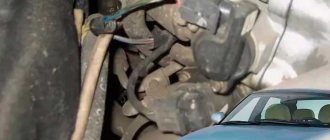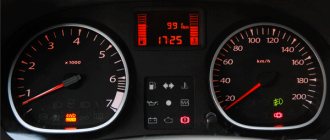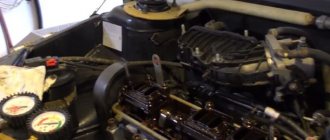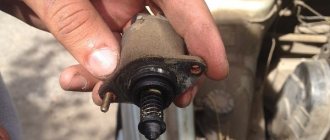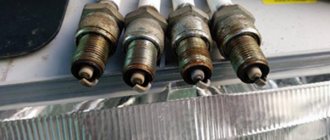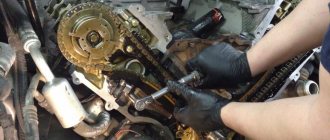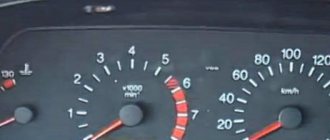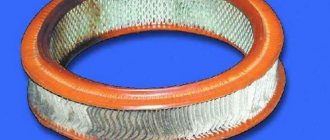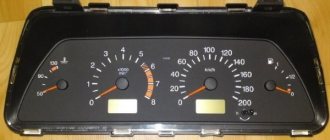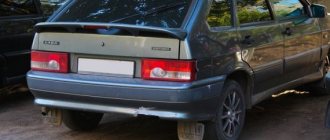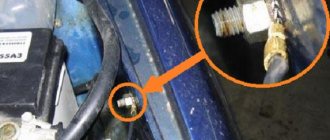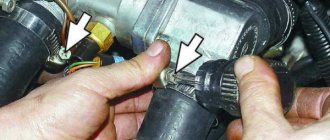Since purchasing the car, there have been drops in speed when releasing the gas and when you raise the speed to 2-3 thousand. The tachometer needle did not stand clearly, but floated a little. This really infuriated me and I tried to solve this problem little by little. -I started by replacing the rcx and it didn’t give me anything.
-I cleaned the throttle body and got no results.
-I decided to flash the Euro 2 car because the catalyst was removed (there was a spider) and there was a fake on the second lambda.
I followed the advice of people on the Internet and flashed the car, the result pleased me, but it didn’t solve my problem, I asked the guys what the problem might be and they spent a very long time digging around, measuring the voltage on each sensor, looking at some graphs and said: “that all the sensors are in order, there is no need to change them, but the voltage on the lambda jumps at the same level as the engine speed increases and they say that you put the second lambda that we turned off for you in place of the first one and the problem should go away”
As a result, I plugged the hole for the second lambda and put it in place of the first one, and of course the result was zero. -I also adjusted the valves and nothing changed.
I was already desperate and didn’t know what to do about it and saw a video on YouTube where a car had exactly the same problems, a person threw a lot of money on sensors and it turned out that the ECU has mass and it oxidizes, you clean it and the problems go away.
After 15 minutes I was already on the street and removed the side console at the passenger’s feet, unscrewed the mass, cleaned it up, started it up and lo and behold. All the problems went away, the idle became super smooth, dips, floating speed, everything disappeared.
So, a note to those who are struggling with similar problems, there is also this option.
Does the car stall when you let off the gas? List of possible problems
Surely every car owner has experienced such an unpleasant situation when the car stalls when releasing the gas.
This problem is one of several most common. To begin with, I would like to clarify why the engine may be plugged during a reset. The very first and most common problem is the banal clogging of the gap in the throttle valve. Another equally popular problem is the dying of the regulator, and they can break quite often. It’s not uncommon to hear from people that it got to the point where they had to completely change it. Or some people benefit from a very serious and deep flush.
Problems and their solutions
The car stalls when you let off the gas - but what exactly lies behind this problem? Everything is quite simple, after reaching a certain speed, the foot is removed from the gas pedal and the car simply stalls. With all this, when the ignition is applied and at idle, everything works more than with a bang.
Despite the advice given above, the problem may not be solved, since they are general preventive measures for a stalled engine. As for the problem itself, it’s worth paying attention to several sensors.
Throttle valve
If after all the checks and measurements carried out above it was not possible to identify a malfunction, then all that remains is to check the condition of the throttle valve assembly. To do this, the part should be dismantled and then cleaned of dirt using cotton swabs. The cleaned part (or rather, all its pipes and tubules) is blown with compressed air using a compressor.
Special attention should be paid to the channel that serves to remove gases from the crankcase. Before starting purging, it should be filled with a cleaning compound and allowed to stand for some time, after which the purging itself should be performed. This is caused by the extremely small diameter of the internal channel, as a result of which other methods of cleaning it are simply not available.
In addition to all of the above breakdowns, a breakdown of the DPKV sensor, as well as the Hall sensor, can also lead to “floating” speed. If they fail, the Check Engine light will light up on the car panel. If such a malfunction occurs, it is best to contact a service center, since special equipment is required to check these sensors.
Sensors
The first of them is the idle speed sensor. This device is located in the engine control system. It is used in cars to stabilize idle speed. Its abrupt performance often precedes the engine turning off when the gas pedal is released. If this is exactly the sequence, then with a 90% probability this particular sensor is involved and you need to start digging in its direction.
As you can understand, this sensor is designed to supply air to the engine to maintain normal idle speed. This sensor is a very important component of the entire fuel supply system to the engine, and it works closely with the injection system.
Second
– this is an air flow sensor, it is located in the same system as the previous one, only it works more globally and is responsible for a greater number of operations.
Speed sensor
The sensor is located on the top panel of the gearbox. If it fails, the engine will stall, problems with increased fuel consumption, poor speedometer performance, reduced engine power, and shutdown for strange reasons will be noticeable. We check using a multimeter:
- Remove the sensor from the box.
- We set the tester to the alternating voltage change mode;
- We close the tester probes to the contacts: the first - going to the dashboard (it is in the center), the second - to the ground contact;
- On the front of the body you will see a rod, its rotation affects the operation, so for testing we need to twist it.
If there is no voltage surge on the device during rotation, then the device is faulty.
Other reasons and their solutions
Another reason may be the wedge of the XX valve. This problem can be temporarily solved by simply tightening the throttle cable a little. Then see what happens. The notorious XX sensor can also be involved here. It also contains more than a dozen problems, but most of them can be solved by simple washing.
It is the sensor that is washed
, or to be more precise, its components in the form of a needle and its hole where it enters. Checking its functionality is quite simple, you need to remove the sensor itself, activate the connector, then disconnect the battery for a short period of time, then connect it again and turn on the ignition, you will see how the needle begins to make forward-return movements.
Another reason could be the battery terminal. In order for everything to be in order, it needs to be reset, so that it can incorrectly transfer data to the engine control settings.
This procedure resets all system settings, and it will again learn to gain and maintain the correct idle speed, and only 3-5 trips may be enough for this. This does not always happen, but still, such a process is called “self-learning”.
It is also possible, and even necessary, to check the injectors; it is possible that the problem lies in their contamination or even technical wear, and, as a result, in their malfunction. Read the article “How to clean injectors”.
Washing everything and everyone should be done exclusively with WD-40 washing liquid.
Trouble-shooting
If the idle speed of your VAZ 2114 fluctuates, then the search for causes should be carried out in the following order. First you should check the condition of the spark plugs. Very often they can lead to such a problem. If the spark plugs are oxidized, have carbon deposits or other contaminants, they should be cleaned and engine operation checked. An even more accurate check can be carried out by replacing old spark plugs with new ones.
It should be remembered that the spark plugs should only be replaced as a set (all 4). It is impossible to replace only one “suspicious” or definitely faulty spark plug; all the others must be replaced as well.
If the spark plugs are in order, then you need to check the integrity of the armor wires and, if broken, replace them. The next step is to check the air filter. If it is heavily soiled or damaged, it should also be replaced with a new one. If after such replacements the motor still does not work stably, then you should proceed to checking the electronic elements.
A trip to the workshop
As you can see, everything described above can be done by a person who knows the structure of the car, but there is nothing for a beginner, because not every novice car enthusiast knows where the XX valve is located, much less its sensor. There is a high probability that outside interference will only make everything worse, or will break or spoil something that was originally in working order. So here it’s worth setting priorities and logically assessing your chances of correcting all problems yourself.
Naturally, in moments when the car stalls when releasing the gas, few people are interested in why this is happening, so it would be very advisable to call a tow truck and tow the car for repairs, or, if the situation is not completely dire, then you can drive to the repair shop yourself .
Spark plug
The first thing worth checking when looking for the reasons for floating speed on a VAZ 2114 (injector) is the spark plugs. Unscrew them and inspect their condition. They should not be oxidized, uneven soot, oil, etc. They should have a brown or gray-brown soot, without any deposits. If so, the spark plugs are in working order. In cases where the replacement took place a long time ago, it is more advisable to immediately replace them with new ones, regardless of the condition. Remember that spark plugs need to be replaced every 20-30 thousand kilometers. If a warmed-up engine returns to normal operation, then this is another sign to look for a problem in the spark plugs.
After revving the VAZ 2114, the speed drops
Hi all. We have the following problem: a VAZ-2114 car, manufactured in 2007, mileage 80,000 km, with power consumers (headlights, heater, etc.) on, the car almost stalls when the gas is released, the revolutions drop to 400-500. If you turn everything off, the motor works as it should. If you remove the wires from the generator, then everything works fine, because of this, the first thing they did was change the generator, it didn’t help. Then it was replaced: (or checked) IAC (2 times) DMRV spark plugs Measured compression (everywhere 12) Measured pressure in the fuel rail (about 3 points) Removed the fuel pump to check the mesh (perfectly clean) Reflashed the ECU Straightened the mass on the body, engine, ECU The throttle has been washed. There seems to be no air leakage from the mass air flow sensor to the throttle. Charging OK
Nothing helped! There is a suspicion that the 1st injector is faulty, because... In the 1st cylinder the spark plug is all smoked.
For clarity, I am posting a video of a faulty car (link No. 1) and for an example video (link No. 2) of the same car with all power consumers turned on (the standard, as it should be :))
Where to dig next?
